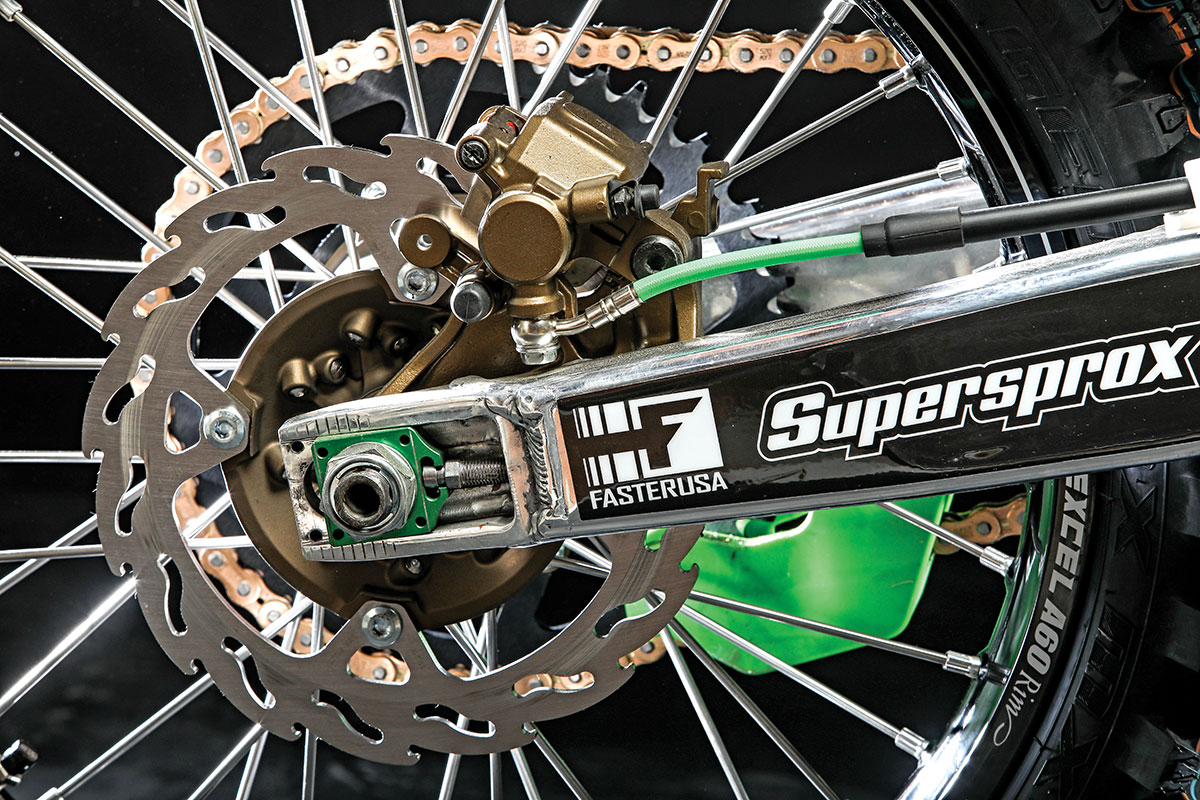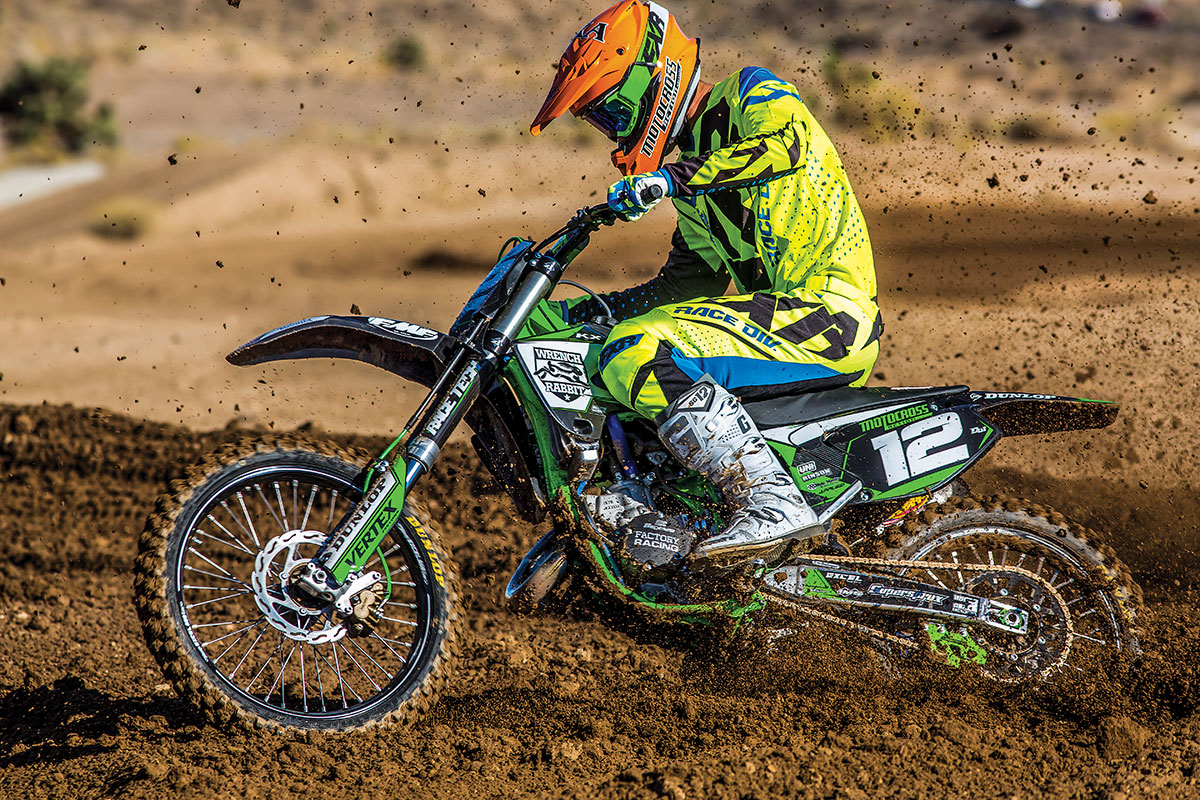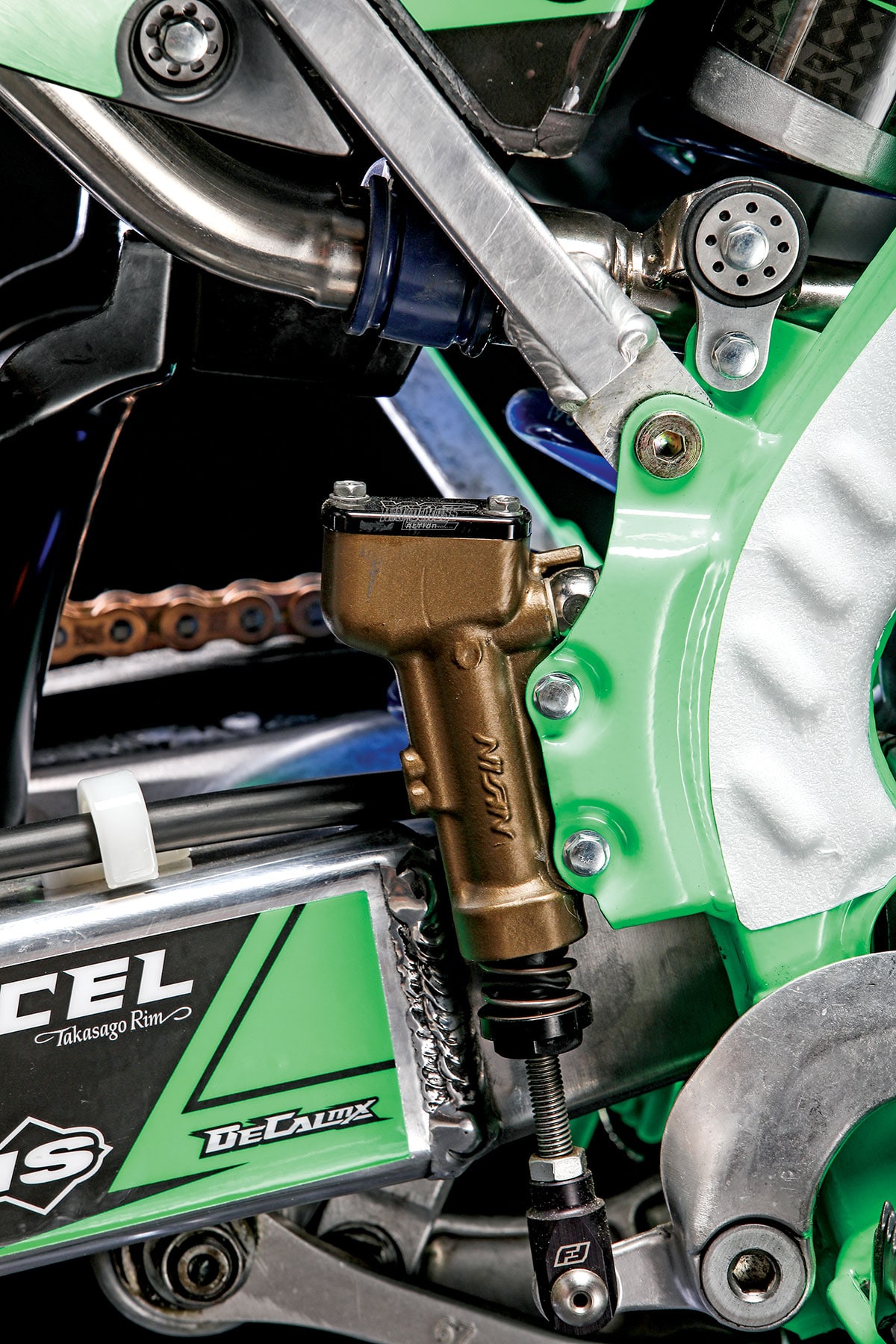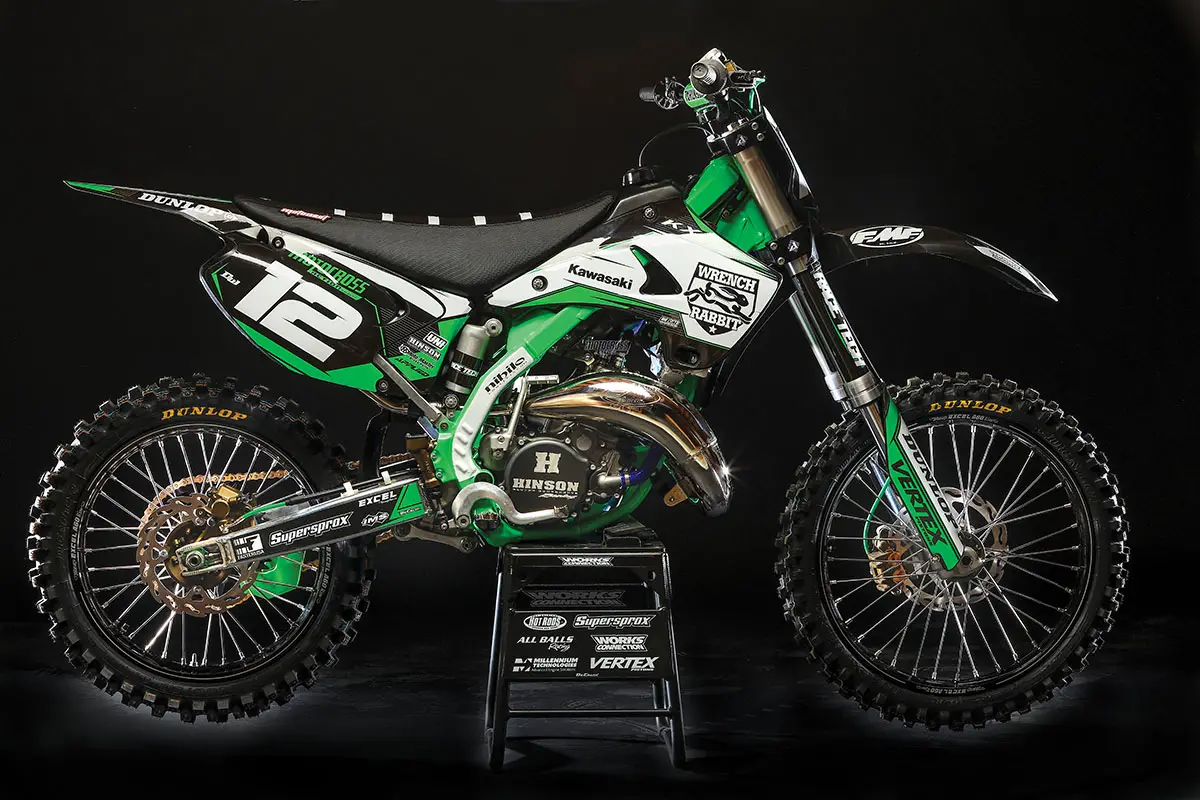DARYL ECKLUND GAMBLES ON A BEAT-DOWN 2003 KAWASAKI KX125
By Daryl Ecklund
Buying a used bike is a gamble any way you look at it. Maybe the odds are in your favor, or maybe you’re putting all your chips on black. You never know what to expect when the title changes hands from one owner to another—if there is a title at all. Doing your homework and being an educated gambler removes a lot of the risk, but no odds are better than buying a brand-new bike off the showroom floor. Even then, however, bad luck can strike. Case in point: the first batch of 2018 Honda CRF250s that hit dealerships turned out to be lemons, as their clutches exploded in enough numbers to have all of the 2018 CRF250s recalled. Nothing is worse than throwing down a big chunk of your hard-earned money on a product that fails before the first oil change.
IT WASN’T THE TIDDLER’S FAULT. IT WASN’T THE GUY WHO SOLD ME THE DILAPIDATED SMOKER’S FAULT. IT WAS MY FAULT. I BOUGHT IT FROM A FRIEND OF A FRIEND WHOM I TRUSTED (MY FRIEND, NOT HIS FRIEND).
I have experienced this pain firsthand. In fact, it wasn’t long ago I paid off a 10-year-old debt from buying two new 2006 Yamaha YZ250Fs. One was a lemon and blew up within a few hours. I was left with one bike to race the AMA Supercross series with. At the end of the season, I was left with one bike, a box of parts and a $13,500 balance. The funny thing is that with a six-month no-interest loan, if you don’t pay it off within those six months, the interest rate spikes! That spike makes it nearly impossible to ever pay off. I learned a lot about ARPs, raising interest rates and the cost to rebuild four-strokes really fast in my teenage years.
Did you know it was legal to raise the interest rate on a credit card without informing the customer before 2009? Legally, credit card companies could raise interest rates as high as they wanted—and they did. Back when the economy was in the dumps, the First Premier Bank credit card had an interest rate of 79.9 percent! Today, the blood-sucking banks are still hiking them as high as 36 percent, but now they have to legally inform you that they are doing it.
TIME WAS PASSING BY SLOWLY, AND THE MXA GUYS STARTED TO REFER TO MY KX125 AS THE “GREEN UNICORN.” I TOLD THEM THAT IT WOULD BE FINISHED SOON, AND THEN THEY’D BE SORRY.
Little did I know when I purchased my used 2003 Kawasaki KX125 to restore that it would become a living nightmare. It wasn’t the tiddler’s fault. It wasn’t the guy who sold me the dilapidated smoker’s fault. It was my fault. I bought it from a friend of a friend whom I trusted (my friend, not his friend). It was the first bike I ever bought that wasn’t in running condition. In short, I was buying a rolling chassis and a box of parts with no title upon purchase. The seller told me that he would get me the title in a day or two. I should have put my wallet back in my pants and walked away, but I knew where he lived, knew all of his friends and had his phone number. He would have some nerve not to get it to me, right?

In the past, I have always been able to start a bike before buying it. Just by starting a used engine you can learn a lot. You can inspect for oil leaks, rough jetting, air leaks and suspicious rattles. I always take a helmet with me and insist on riding the bike down the street. It allows me to check for blown-out suspension, useless brakes, base-gasket reliability and to see if the engine runs strong. Craigslist ads are more often than not deceiving and dishonest. The only people making money on most Craigslist used-bike sales are Maxima, Scotch-Brite and Acerbis—because the seller uses up a lot of Maxima SC-1, and Scotch-Brite pads and new plastic to make an old dog look new.

I asked all the right questions when looking at the KX125, but didn’t inspect the parts as closely as I should have. I haggled to get the price down from $650 to $400 for what I thought was a good deal. My plan was to jump right on it when I got home and tear it down to the frame. Sadly, family, work, riding and more riding got in the way of restoring the KX125. I had ordered a complete engine kit from Wrench Rabbit (one part number for the complete bottom-end kit, main bearing/seal kit, tranny bearings, complete engine gasket kit and Vertex piston kit) the same week I bought the bike, but that didn’t encourage me to get started. Jay Clark always called and asked how my KX125 project was coming. Instead of telling him I hadn’t started, I told him about my trip to Holland to race, how busy I was at MXA and that my youngest was walking—nay, running—now, and I had a hard time keeping up with him. Jay always offered to help with the build, but I told him sternly, “No, I want to do it myself.”

Finally, push came to shove as the other MXA guys started making fun of my non-existent 2003 KX125 project bike. So, I did what anyone would have done—I took up a friends offer to help me get the bike finished. The day after I rolled the KX125 into his garage and handed him the box of parts that the friend of my friend had given me, I got a call from him telling me that there was no rear brake pedal, front brake master cylinder, wiring harness, spark plug cap, power valve cover, mud flap—and the list went on. Heck, maybe I forgot a box in the shed. Nope! That wasn’t the worst of it, the carburetor wasn’t the right one for a KX125. I called the friend of my friend, but he didn’t answer…ever.

Since I had someon ehelping me to get the job done and to do all of the hard work, we sent the frame to San Diego Powder Coating to get it painted Flo Green. Then I started scavenging eBay, Craigslist and dealerships to piece the bike together. Kawasaki had long since stopped producing parts for older KX two-strokes, so it was tough and expensive to find the parts. It took almost a year to track everything down. Many of the OEM parts that we couldn’t find we were able to source at aftermarket companies such as All Balls, Excel wheels, Pivot Works, Fasst Co, TM Designworks, Tusk, Boyesen, Motion Pro, Bolt Motorcycle Hardware and Works Connection. Without these companies, restoring old smokers would be next to impossible.

Time was passing by slowly, and the MXA guys started to refer to my KX125 as the “green unicorn.” I told them that it would be finished soon and then they’d be sorry. Unfortunately, that was when I found out that the cylinder was in bad condition and the airbox was broken. We weren’t even sure if the cylinder or airbox were salvageable. While I sent the old cylinder to Millennium Technologies to see if they could salvage it, I started browsing eBay again. Millennium Technologies stripped the cylinder’s material down, repaired the damage and re-plated it to the stock displacement. They brought the cylinder back to life, which saved me time and money. As far as the KX125 airbox, no luck. We ended up bonding it together. It wasn’t perfect, but it was our last resort.

The suspension needed serious TLC. I have always had good luck with Race Tech when it comes to refurbishing old, beat-up suspension components. I got the components back within a week looking like new. Other parts that needed TLC were the radiators and hubs. The radiators were bent, and the fins were pushed in. We had ICW radiators in North Carolina straightened and braced them for durability. The hubs had lots of nicks and were discolored from being left outside. Faster USA did an awesome job cleaning them up and Cerakoting them a Burnt Magnesium color. To match the color of the hubs, we sent Faster USA the front and rear brake calipers and master cylinders to get coated the same trick-looking color. My goal had been to make the bike all Flo Geen, but aftermarket plastic companies stopped making the color. The frame was already powder-coated, so I decided to go to black plastic from UFO. I enlisted DeCal Works to incorporate the Flo Green theme I was looking for into the graphics.
I WANTED A LOW-MAINTENANCE BIKE THAT WOULD STAND THE TEST OF TIME—AND IT SEEMED SILLY TO HOP UP A 2003 125 ENGINE GIVEN THAT NOTHING I COULD DO TO IT WOULD MAKE IT RUN LIKE THE RACE BIKES I TESTED FOR A LIVING.

There were a few modern updates. (1) We had Applied build custom triple clamps that allowed us to use the modern front number plate and front fender off the current KX line. (2) Back in 2003 Honda had a patent on modern routing of the front brake line. To avoid Honda’s patent, Kawasaki wrapped the brake hose under the fork lug. Not the safest place for it to be, so I used a current KX250F brake hose and slightly modified 2018 RM-Z fork guard to bring the routing up to date. (3) The standard 2003 KX125 rear axle nut uses a cotter pin. The cotter pin looked dated and was a hassle to deal with. We used a self-locking CRF rear axle nut to replace it.

What about the powerplant? I wanted to keep everything internal in stock condition. I wanted a low-maintenance bike that would stand the test of time—and it seemed silly to hop up a 2003 125 engine given that nothing I could do to it would make it run like the race bikes I tested for a living. I wanted it to run well, so I used the two parts that any KX125 racer would have used back in 2003—an FMF Fatty pipe with Shorty silencer and a Boyesen reed cage.

On the track, the restored 2003 KX125 performed better than when it came off the showroom floor 16 year earlier. Rebuilding the top end, suspension, cranks, bearing and seals made the old KX have that newness feel of everything being tight. Nothing rattled, vibrated or leaked. It was all I could have hoped for. By no means is this a competitive 125cc machine by today’s standards, but that wasn’t my intention. I wanted a fun bike that looked good, which is exactly what I ended up with.
This entire process taught me valuable lessons. I learned to do my research before buying a bike in a cardboard box. I learned that the parts you take for granted are the hardest ones to find. I learned to check the cylinder, cases and frame for cracks. I learned that I could get a pink slip without dealing with the seller by going through AAA. I learned that a good deal is also a good opportunity to lose money. I learned that a job I thought would take a month or two could eventually take five years. I learned that all the trouble was worth it to have a pristine 2003 Kawasaki KX125 sitting in my garage.

2003 KX125 SUPPLIER LIST
www.wrenchrabbit.com
www.fmfracing.com
www.mt-llc.com
www.supersproxusa.com
www.pivotworks.com
www.dunlopmotorcycle.com
www.allballsracing.com
www.fasterusa.com
www.hinsonracing.com
www.moto-masterusa.com
www.unifilter.com
www.ufoplasticusa.com
www.racetech.com
www.motoseat.com
www.worksconnection.com
www.sandiegopowdercoating.com
www.decalmx.com
www.fuel-star.com
www.imsproducts.com
www.motionpro.com
www.renthal.com
www.klotzlube.com
www.boltmotorcyclehardware.com
www.cycraracing.com
www.appliedrace.com
www.icwbikestands.com
www.fasstco.com
www.nihiloconcepts.com
www.tmdesignworks.com
www.tuskoffroad.com
www.rkexcelamerica.com
www.boyesen.com







Comments are closed.